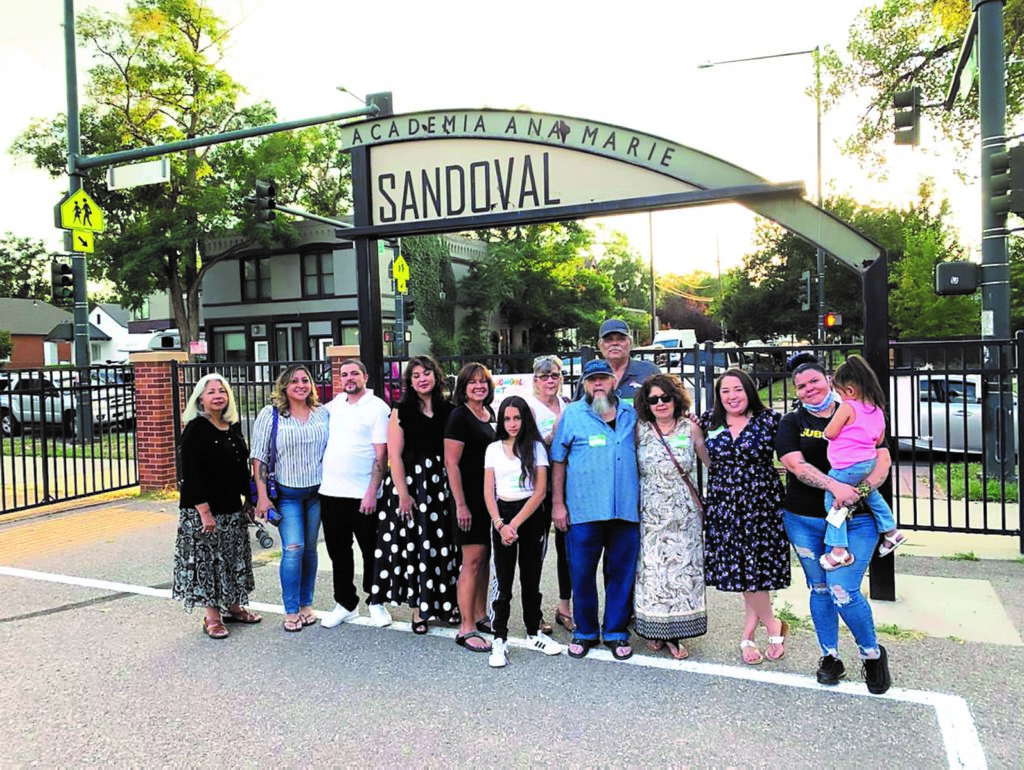
Academia Ana Marie Sandoval is celebrating its twentieth anniversary! The dual-language Montessori school was the first of its kind when doors opened in August of 2001. Padres y Jóvenes Unidos, a community organization led by people of color, worked in tandem with parents and other community members to develop this unique educational model for children from three years of age through sixth grade.
Current principal Sandra Berumen emphasized the school is a Montessori school, not a “Montessori-like school,” meaning teachers must undergo intensive training to learn the Montessori method, a method “based on self-directed activity, hands-on learning and collaborative interaction created by Dr. Maria Montessori,” according to the school’s website. The dual-language component of the school model means students are taught literacy and content in both English and Spanish, with the goal of creating a bilingual and biliterate student body.
Founding principal JoAnn Trujillo Hays recalls early skepticism from parents as they asked her “how can you guarantee that my child will be bilingual by the time they leave?” Trujillo Hays simply replied, “Because I’ve seen it.” At the time, Trujillo Hays was principal of Escuela Bilingue Washington in Boulder and she had witnessed fifth graders engaging in complex debate topics in English and Spanish. The fifth graders never broke code, meaning they were able to actively participate in the debate without switching back to using their native language.
Though Trujillo Hays was not looking to leave her position in Boulder, the idea of joining the grassroots efforts to create Academia Ana Marie Sandoval intrigued her, and she accepted the principalship in February of 2001, mere months before the school was set to open. From the very beginning, Trujillo Hays believed the school would be successful, stating, “A proven model like Montessori, and another like dual language, how can it not work?”
Combining dual-language education with Montessori education presented many early challenges, some that persist to this day. One such difficulty is recruiting qualified teachers. Berumen highlighted how the Montessori method requires a teacher’s assistant in each classroom, which necessitates finding and hiring bilingual paraprofessionals, in addition to the already daunting task of finding and hiring classroom teachers.
Another ongoing challenge is maintaining a balance between native English-speaking students and native Spanish-speaking students. Trujillo Hays noted in an ideal world, the ratio would be 50/50, but from the beginning the school operated closer to a 60/40 model, with native Spanish-speakers comprising 40% of the student population. To maintain this delicate balance, the school always accepts native Spanish-speakers and has created a waitlist for native English-speakers. The same practices are in place to this day, and Berumen asserts around 40% of students are what they call ‘Multilingual Language Learners,’ formerly known as English Language Learners.
According to Berumen, a more recent challenge has been explaining the Montessori model to parents, as she emphasizes the parents “came to the school because they were enticed by the model, but not necessarily because they understood it truly and what it means for their child.” For this reason, the school has initiated a series of parent education nights designed to explain the model and how parents can best support their students at home.
At the twentieth anniversary celebration last month, the school honored its namesake: late civil rights activist Ana Marie Sandoval. Sandoval was born in Denver in 1939 and spent her lifetime advocating for various causes, including becoming heavily involved in the Chicano rights movement. Despite battling cancer for more than a decade before passing, Sandoval remained an active community member, including organizing rallies and answering near constant phone calls from community organizers asking her advice.
Ana Marie Sandoval’s granddaughter, Justine Sandoval, remembers her as someone who was instrumental in helping to desegregate Denver Public Schools, which she notes is interesting because “now if you look at the statistics, DPS is more segregated than it was pre-segregation because of the demographic changes in the city and school choice.” One major indicator of the demographic changes North Denver has experienced is the continuous decline of Academia Ana Marie Sandoval students receiving free or reduced lunch. Presently, only 32.4% of students are receiving free or reduced lunch, a number quite low considering the district wide statistic of 61.73% of students who are eligible for free or reduced lunch.
Berumen is quick to acknowledge the gentrification that has occurred in North Denver, and she remains committed to ensuring the school is honoring its Latino heritage while providing a quality education for all students. “I honestly do believe that every child deserves an education like the one they get to have here,” says Berumen.
Nora Ridgeway is a 2008 graduate of Academia Ana Marie Sandoval and currently resides in Sunnyside

Such a wonderful testament to the school. The school works and is shown in the intellectual writing of a graduated student.
Wonderful!
Excellent article.
Orgullosa de haber sido la maestra de una chica tan brillante como tu! Cariños
Maritza
Muchisimas gracias por todo, Maritza! ❤️❤️
❤